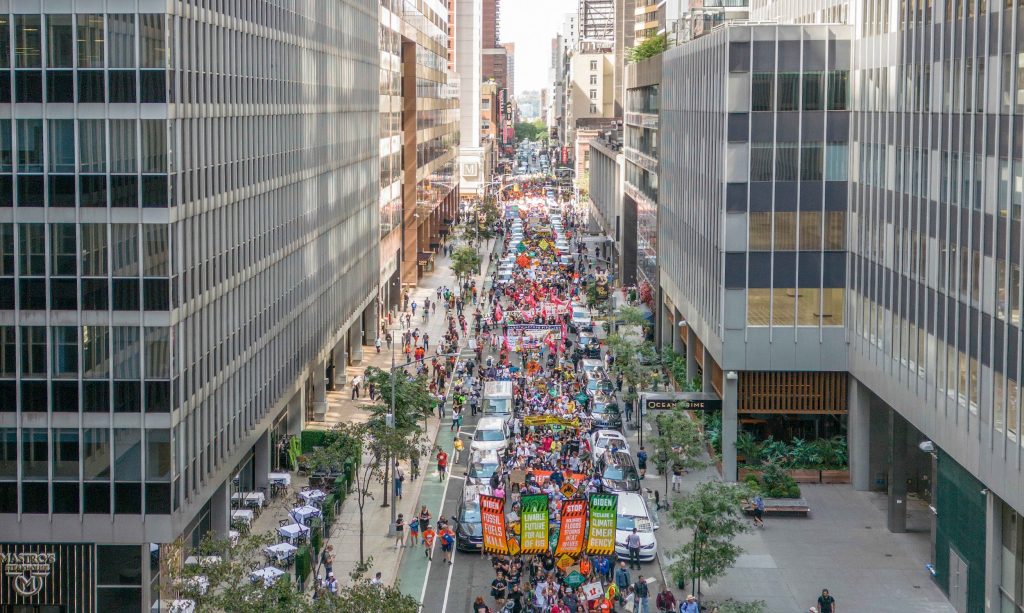
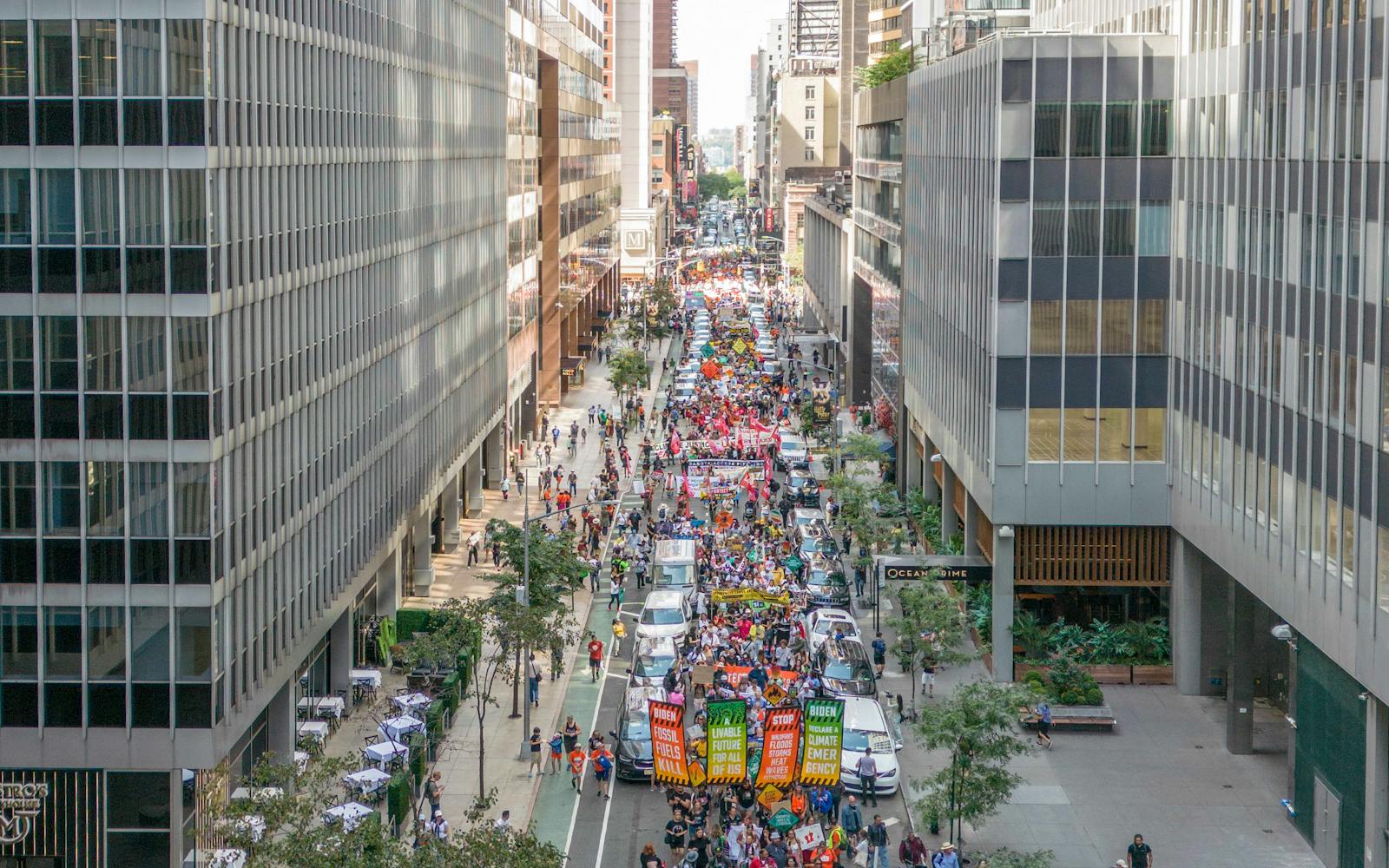
Thousands march in the streets for climate action during UNGA78 in New York City. Photo: UNF/Carbon Stories
From apocalyptic weather to devastating violence to groundbreaking conversations on artificial intelligence and gender, these are the moments and issues that defined the past 12 months.
2023 was a year of halfway points, turning points, and stalled progress as the world grappled with a series of cascading challenges that pushed millions of people into poverty, hunger, and harm’s way. Ongoing and new outbreaks of conflict destroyed lives and homes, displaced millions, and further divided an already polarized planet. Meanwhile, humanitarian agencies struggled to keep up.
This year also proved that the era of “global boiling” has arrived, as UN Secretary-General António Guterres declared earlier this year. “Climate change is here. It is terrifying. And it is just the beginning.”
We asked leaders across the UN Foundation to reflect on how 2023 changed our world — from the highs and the lows to the moments that could recast our future.
Taking stock of global progress
2023 marked the midway point for three major agreements led by the UN in 2015: the Sustainable Development Goals (SDGs), the Paris Agreement, and the Addis Ababa Action Agenda on development finance. To evaluate global progress and generate renewed investment for each, the UN brought diverse stakeholders together throughout the year, including at the SDG Summit, the UN Climate Change Conference (COP 28), and other major events. The year also saw breakthroughs on calls for international financial institution reform and the Bridgetown Initiative. At the same time, natural disasters and man-made crises continued to divert attention and resources and to further erode trust within the international community.
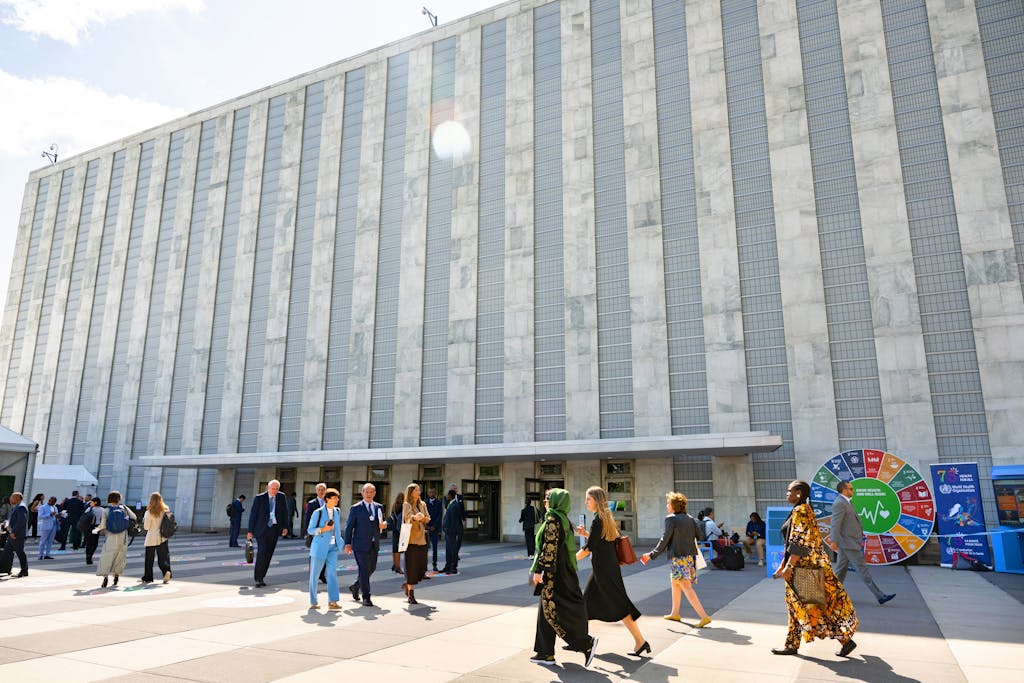
The scene outside of UN Headquarters during UNGA 78 in New York City. Photo: UN Foundation/Diane Bondareff
Michelle Milford Morse (M3), Vice President, Girls and Women Strategy: This enormous gathering of people in New York City seemed to come along with what felt like renewed ambition and a lot of energy. But then days later unfathomable terror, violence, and trauma erupted in Gaza, Israel, and the Middle East region — which has only continued to deepen. I think we’re really being tested now by our ability to keep focused on long-term goals while we also answer the call to respond to immediate humanitarian catastrophes and conflict everywhere it exists.
David Steven, Senior Fellow: I’ve described the SDG Summit as the “Olympics of the SDGs” because it happens every four years. So we really needed to bring a lot to this summit and use it as a springboard for the next four-year cycle. I think it was very hard for the UN and the Member States to do that when so much is going on. But for most of the big issues that countries are facing, the solutions are very seldom within national borders. And that creates continual demand for international cooperation. These summits are important insofar as they bring together people with the capacity to actually make substantial progress on the Goals and targets. We need to find the people coming out of these summits who really have a sense of what can be achieved. Work out where the doers are, empower the doers, and ask them to bring commitments to change to the Summit of the Future in 2024.
Caroline Kleinfox, Director, U.S. SDG Policy Planning: In the U.S. context, one clear highlight this year was President Joe Biden referring to the SDGs by name and renewing the United States’ commitment to the SDGs both domestically and internationally during this year’s UNGA. This is the first time we’ve seen a sitting president in the U.S. talk about the SDGs since 2016. This was a really important point — both for the momentum of the 2030 Agenda and also for morale among people who have been working to shape attention and direction on the SDGs in the U.S. It was a signal that there is a potential opening for increased activity and collaboration next year. Meanwhile, across the world, you can see creative ways of reporting on the SDGs coming from communities that are learning from each other. It’s also been really interesting to watch public-private partnerships and community organizations come forward as real champions of the Goals and also as mechanisms to hold attention and memory over time, which enables the 2030 framework to continue across different political moments that often have a shorter life cycle.
On COP 28 and the Global Stocktake
Pete Ogden, Vice President, Climate and Environment: We knew all year that this was shaping up to be a major COP. As the urgency of the climate crisis reached new heights in 2023, COP 28 marked the first official Global Stocktake of the Paris Agreement, in which countries — and the world — would take a hard look at where we stand in relation to our climate goals, confront just how much more needs to happen, and marshal the political will to do it.
There were certainly some encouraging signs, as countries, sub-national actors, and others came ready with major announcements from the outset. A new Loss and Damage fund was established and backed with pledges of more than $700 million to help people cope with mounting climate impacts. Every country agreed to the goals of tripling global renewable energy and doubling the rate of energy efficiency by 2030. The Secretary General’s Early Warnings for All Initiative garnered even greater support and visibility. Billions of dollars of additional funding were pledged to the Green Climate Fund. And, a first-of-its-kind food and climate declaration was backed by more than 150 countries.
But above all, the intense negotiation of the Global Stocktake shone a light like never before on one of the most fundamental — and also most contentious — challenges at the heart of the climate crisis: the future of fossil fuels. No issue loomed larger over the negotiations — and it dragged the COP into overtime. Ultimately, a clear and bold agreement to rapidly phase out fossil fuels proved elusive. But for the first time, countries agreed on the need to “transition” away from fossil fuels and replace them with clean energy. And now, the road to COP 29 in Baku, Azerbaijan begins.
On Financing
Julie Kofoed, Senior Director, Sustainable Development Initiatives: One interesting thing about 2023 is how the conversation on reforming international financial institutions moved from a niche topic into the mainstream. Finance ties into the larger conversation around reform and underlying assumptions of our current system and what needs to change in order for us to actually achieve the SDGs. And that’s one of the main calls of the Global Sustainable Development Report that came out this year.
Climate Wins and Record-breaking Weather
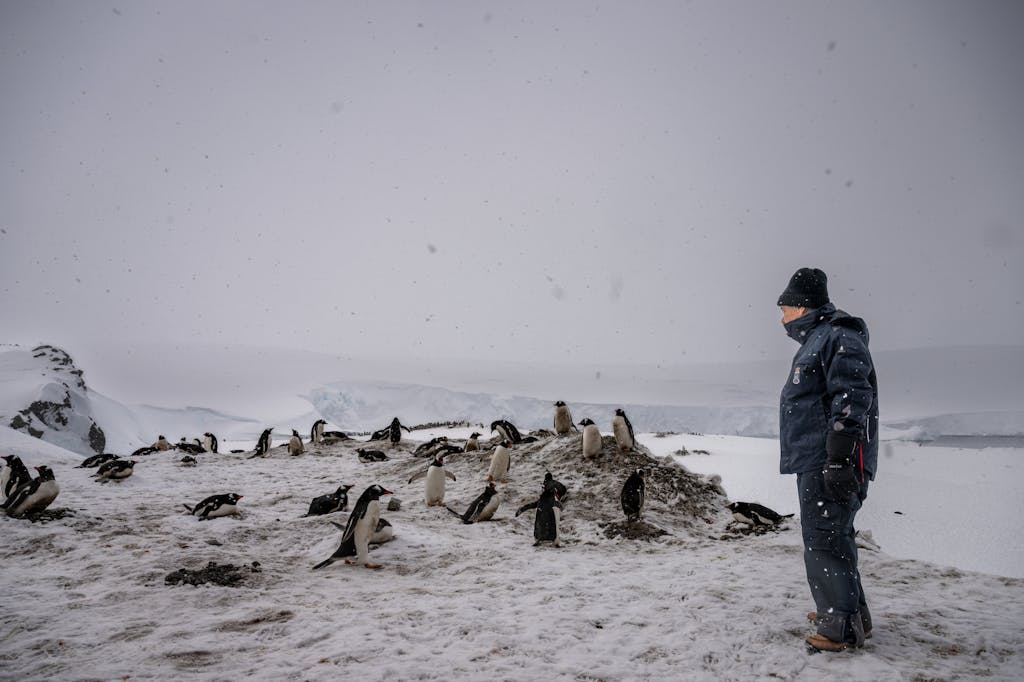
UN Secretary-General António Guterres walks among penguins at the Base General Bernardo O’Higgins in Antarctica, where he saw firsthand the impact of the climate crisis on the world’s southernmost continent. Photo: UN Photo
This year the world experienced catastrophic flooding across 10 countries in 12 days, the hottest ocean temperatures ever recorded, heat waves that scorched the entire Northern Hemisphere, and the worst drought in 40 years across the Horn of Africa. 2023 was the year that climate change became even more undeniable, and the world came together to negotiate major diplomatic wins for the environment, including the High Seas Treaty, the Vanuatu resolution, and the recent agreement by the International Maritime Organization (IMO) to decarbonize global shipping.
Pete: This year’s agreement at the IMO to get global shipping to Net Zero by or around 2050 was a watershed moment in terms of addressing a sector that already accounts for 3% of global emissions and could go up to 10% in the coming decades without this kind of intervention. The IMO now has the task of developing the standards that will make this goal a reality. One of the things the IMO has put on the table as part of this new regulatory arrangement is an “emission pricing mechanism” — which could prove to be an innovative way of thinking about generating much-needed climate finance. This is definitely an area to watch going forward.
Cecilia Mundaca Shah, Senior Director, Global Health: This year made clear that the climate crisis is a health crisis. The health systems we’ve built cannot withstand the unpredictability of extreme weather. Pakistan, for example, made progress on decreasing mortality from malaria after many years of working on it. Then they suffered this terrible flood and all of the gains they made in the past five years were completely reversed. We’re a society that is feeling the effects of climate change — massive effects on our health — and we need to be thinking differently. And I think that’s why it’s so critical that we had an official Health Day at COP 28 for the first time. This is something that the health community pushed for a really long time, and it finally happened this year.
Turning the Page on Global Health
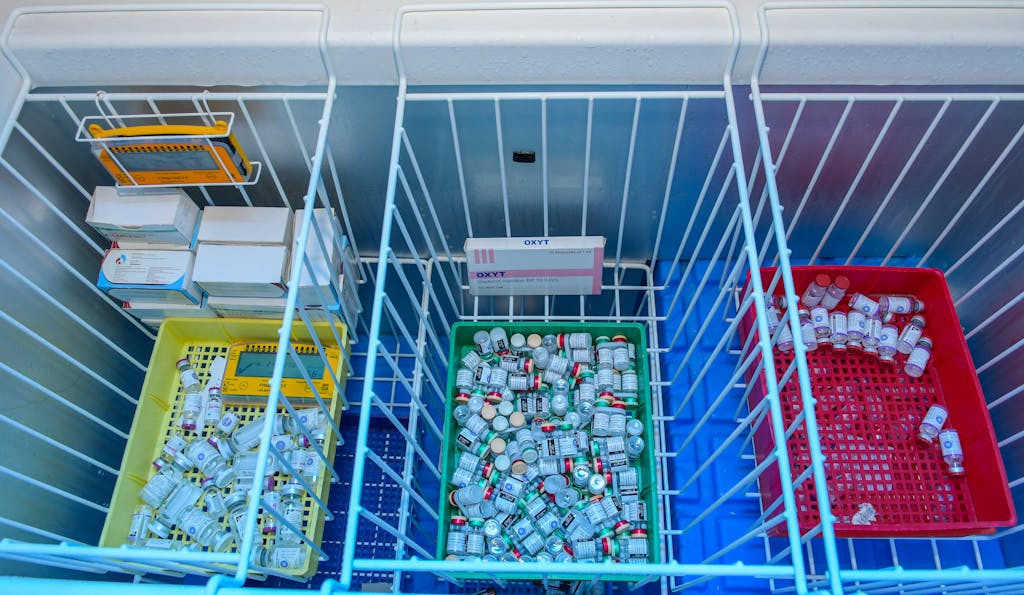
A view of a refrigerator where vaccine vials, including malaria vaccines, are being stored at Kisumu Airport Health Centre, Kenya. Photo: UNICEF/Washington Sigu
In 2023, the World Health Organization (WHO) officially declared the end of the COVID-19 pandemic. The organization also turned 75 years old, prompting a hard look at the planet’s triumphs and failures when it comes to global health policy, including the difficult lessons we learned from the pandemic.
Cecilia: In 2023, global health got a lot of political attention in New York with three high-level meetings: on pandemic preparedness and response, universal health coverage, and tuberculosis. Unfortunately, we cannot avert the next pandemic; it’s going to happen. It’s just a matter of being better prepared. The pandemic treaty that was discussed this year will be such an important agreement so countries have the capacity they need to respond better when the next pandemic occurs.
Lori Sloate, Senior Director, Global Health: For the area of immunization, we saw two glimmers of hope in 2023. The first was around addressing the increased outbreaks of measles, diphtheria, cholera, polio, meningitis, and other entirely preventable diseases. The fruits of the “Big Catch Up” — to rebound from the effects of COVID-19 and catch up to those kids who were essentially aged out of routine immunization because of lockdowns or overwhelmed health systems during the pandemic — really took hold this year with countries and partners coming together in unified ways. The second was the WHO policy recommendation and approval of the second malaria vaccine, R21. In December, we anticipate the vaccine to be WHO-prequalified, which will be the final step to make it available in a scalable and routine way, starting in 2024.
Young People Take Charge
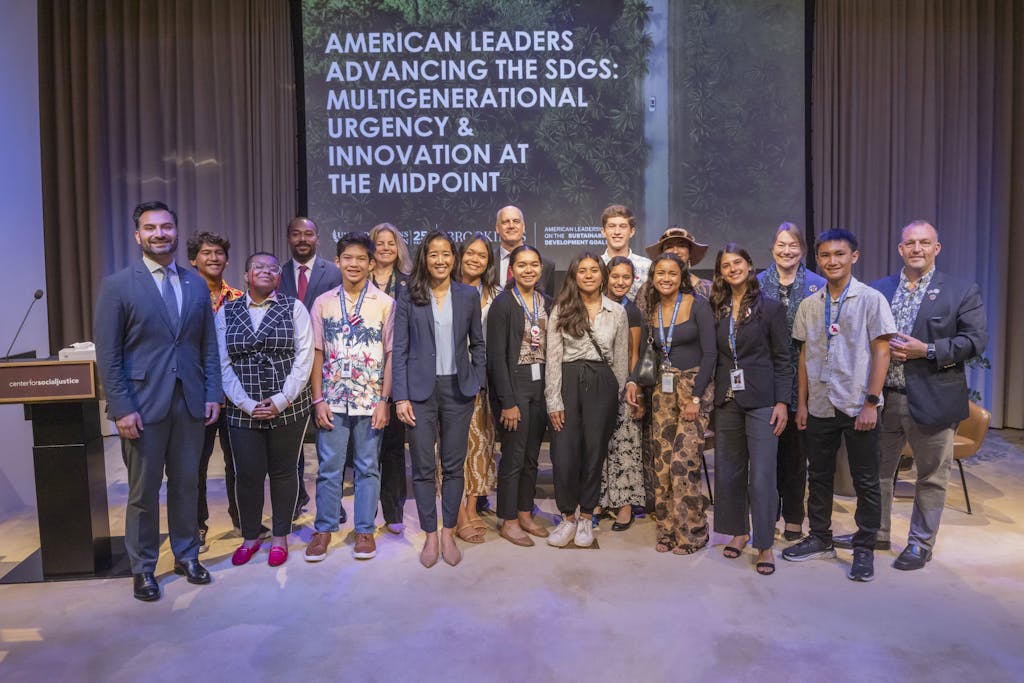
From young people to business leaders to government officials — including a large delegation from Hawai’i — a diverse range of perspectives were represented at the UN Foundation’s event, “American Leaders Advancing the SDGs: Multigenerational Urgency and Innovation at the Midpoint,” during UNGA78 in New York City. Photo: UN Foundation/Carbon Stories
This year, the world continued to undergo a massive demographic shift. 2023 marked the first full year that Earth hosted 8 billion people, and there are more young people alive today than ever before in history. The African continent in particular is experiencing a youth boom. By 2050, 1 in 4 people will be African. In response, the UN launched its first-ever Youth Office to prioritize young leadership within the organization.
Inés Yábar, Lead Next Generation Fellow: The launch of the Youth Office at the UN was a major development this year. We’re very excited about the institutionalization of young people within multilateral processes to make sure we’re not tokenized but actually embedded into the systems that help us design our own future. And at the same time, the UN Foundation has continued to grow the Unlock the Future coalition — reaching one billion people worldwide who are working together to build a better future for next and future generations through their five-year strategy launched at the SDG Summit.
About 80% of the future’s youth will be in Africa and Asia, so we need to make sure those countries are well prepared and well represented. But many young people don’t have a good education, good health, or a good job. We’re not necessarily seeing this as the news, but this is the reality for young people right now.
David: It’s massively important for the future of the world to harness the next generation in an effective way. And the work that the UN Foundation is doing through its Next Generation Fellows and Our Future Agenda is really exploring how to tap that energy and bring it into the international system. We’re seeing young people within a whole range of countries beginning to play a much more important role and really have a voice at the UN.
Caroline: I think that the youth voice in 2023 was incredibly powerful, and they’re bringing a lot of hope and direction to the global conversation. The Hawai’i SDG Youth Council, for example, met with U.S. Ambassador to the UN Linda Thomas-Greenfield and Hawai’i Governor Josh Green this year to make sure young people have a seat at the table. There’s growing hope for us to work together and find means of collaboration across generations.
Standing Together to Defend Our Rights
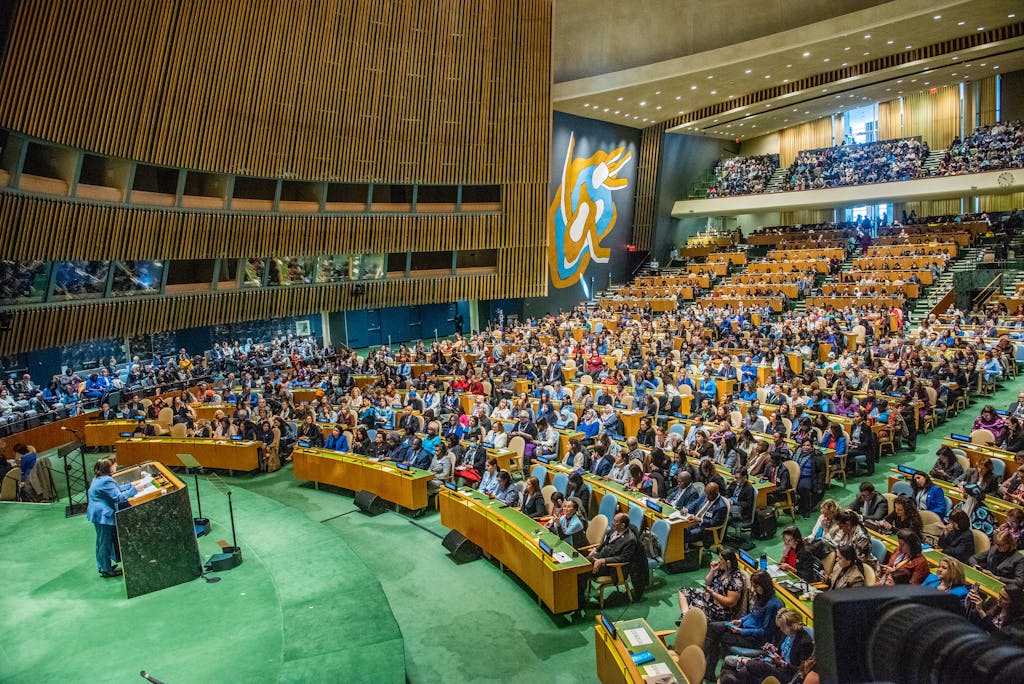
The CSW67 – United Nations Commemoration of International Women’s Day 2023 was held with the theme, “DigitALL: Innovation and Technology for Gender Equality.” Photo: UN Women/Catianne Tijerina
Despite troubling rollbacks in human rights worldwide, this year featured inspiring grassroots solidarity across issues, borders, and especially among women and young people. At the same time, leaps in technology, notably artificial intelligence, prompted renewed and urgent global discussions about safeguarding equality, security, and freedom in the digital realm.
M3: In 2023 we saw a renewal and a flourishing of cross-national and cross-regional solidarity among women, from women in Latin America showing solidarity with women in the United States in the face of really cruel abortion bans to Iranian women standing with Ukrainian women, Rwanda standing with the girls of Afghanistan to make sure they have a school to attend. I think we’re going to look back at 2023 as a year in which peace, security, and gender equality as interconnected issues really rose to the top of mind. And I’m really hopeful that the transnational women’s peace movement holds, even in the face of current conflicts.
Luisa Kislinger, Senior Manager, Girls and Women Strategy: In an important elevation of the issue, the UN dedicated this year’s Commission on the Status of Women in March to the intersection between technology and gender equality. Some very interesting conversations came out of that meeting, including things we don’t even think about, like technology and menstruation apps and how data protection intersects with abortion rights.
Inés: The hope is always in the people more than the processes. A lot of processes have happened this year, but the people who are driving the change, who are mainly the grassroots young leaders — the people we don’t necessarily see on the news — they’re the ones leading the progress in their own countries in their own context. And I’ve seen that through the work that we do in the Engine Room and all these young people that we mobilize throughout the year, as well as on the ground at the UN. They’re advocating and making sure that we’re not digging our silos, but actually building bridges to each other as people. That’s brought me hope, especially seeing the progress we’ve made at being more inclusive.
Meeting the Moment
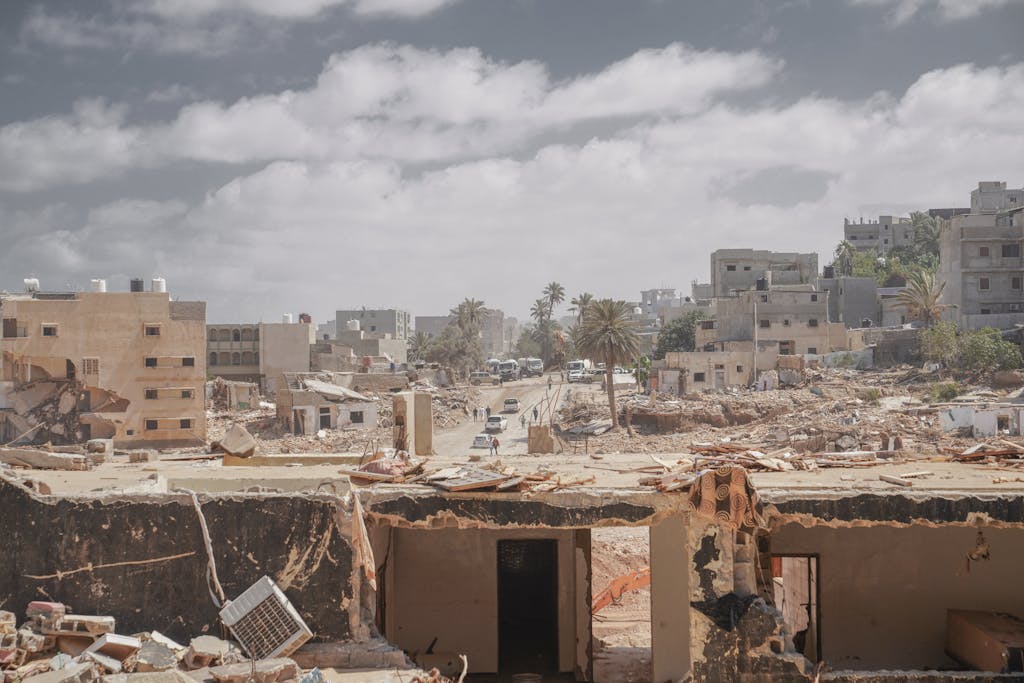
In September 2023, following Storm Daniel and subsequent floods, rubble and debris reveal extensive damage in Derna, eastern Libya. Photo: UNICEF/Mohamed Alatrib
“Our world — particularly developing countries — faces a perfect storm: Growing inequalities. Climate chaos. Conflicts and hunger,” Secretary-General Guterres told world leaders at this year’s G20 Summit.
Our experts agree. Humanity reached a crossroads in 2023. “It does feel like a monumental moment,” Julie said, noting how these daunting problems could inspire a better path forward. “History has shown that in times of great pressure and turmoil and despair, new things can grow.”
As the world looks toward 2024, solidarity won’t be just another buzzword; it will be our only option for survival. In the words of Guterres just before the close of the year: “We need all hands on deck, collaborating and cooperating in a way that has not been done before.”
It is now or never.
Megan Rabbitt, Director, Media and Content, and Dynahlee Padilla-Vasquez, Communications Officer, contributed to this article.

